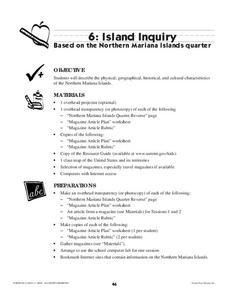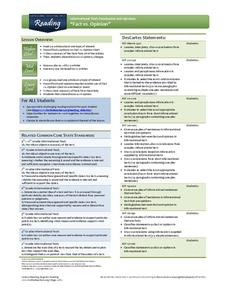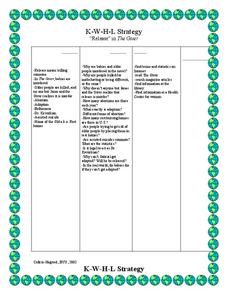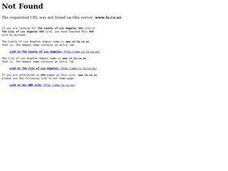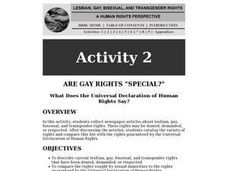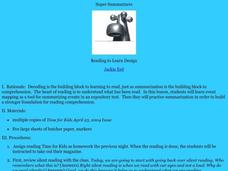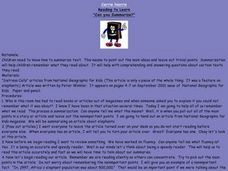Curated OER
Create a Youth Consumer Magazine
To underscore the importance of being informed consumers, kids check out youth consumer magazines and websites and then create their own. Although no detailed plans are included in the resource, it is packed with ideas and suggestions.
Curated OER
Imaginary Wealth and a Magazine Article
Young scholars explore economics by writing a fictitious news article. In this personal wealth lesson, students participate in a role-playing activity in which the year is 2025 and they must write an article about their extremely wealthy...
Curated OER
Fact Or Opinion
Groups of junior highers find newspaper articles which contain both facts and opinions, and present examples of each to the class. The focus is on discerning between fact and opinion. Two excellent worksheets are embedded in the plan...
Curated OER
Hometown Travel Journalism
Steinbeck’s witty memoir, “Travels with Charley: In Search of America,” inspires kids to investigate their neighborhoods as local travel journalists.
Curated OER
Creating a Classroom Magazine
Second graders examine different types of magazine writing, and discuss how to develop topics into information that is suitable for short magazine articles. They write, edit, and compose a monthly classroom magazine.
Curated OER
Island Inquiry: Based on the Northern Mariana Islands Quarter
Students research two physical and/or human characteristic topics of the Northern Mariana Islands in groups of four students. In this social studies lesson, students analyze how to write magazine articles and research the two topics...
Grammar Net
A, An, Some, Any
Practice a, an, some, and any with a straightforward worksheet. Kids fill in the blanks for 20 sentences, using context clues and their knowledge of each word.
For the Teachers
Fact vs. Opinion
Many informational texts are written as factual, but can your learners determine when an opinion is presented as fact? Have your kids read several articles on the same topic and record the statements that contain either facts or...
Curated OER
Now That's Beautiful!
Your class experiences dozens of messages about beauty every day by reading magazines, watching movies, and listening to the radio. Have them analyze society's view of beauty in groups after discussing several resources, including...
Curated OER
The Giver: K-W-H-L Strategy
Explore the theme of release and death in Lois Lowry's The Giver with a K-W-H-L chart. After noting what they already know, kids come up with a list of questions about topics that they would like to know about, as well as how they...
Curated OER
Some Simple Rules to Sum it Up!
Students observe and demonstrate three steps to summarize text. They read and discuss the three steps to summarizing, then silently read an article about dugongs from "National Geographic Kids" magazine. Students demonstrate the three...
Curated OER
Topical Discussions
Engaging in topical discussions can be a great way to teach kids how to build strong arguments and support their opinions with concrete evidence. High schoolers choose a controversial topic, build an argument for or against that topic,...
Curated OER
Are Gay Rights "Special"?
Inspire critical thinking with this activity, which prompts students to compare lesbian, gat, bisexual, and transgender rights with the rights guaranteed by the Universal Declaration of Human Rights. By collecting topical articles about...
Pearson Longman
Back Talk: A Summarizing Activity
Here's resource that presents step-by-step directions for three different activities that ask kids to read a short passage, listen for the main points, and then to summarize the passage in their own words.
Curated OER
Writing as a group activity
Did you know that 50% of all Americans can trace a relative who traveled through Ellis Island? Relive these journeys with your class and then provide sentence strategy templates for them to use to compose their own informative...
Curated OER
Audience-Smash Hits case study
Middle schoolers become familiar with the term audience after examining a story about the magazine Smash Hits and its decision to quit publication. After students study the magazine and methods currently used to receive music news, they...
Curated OER
Master in Training
Students identify and examine their own areas of expertise. After reading an article, they discuss the evolution of three opera high school students. They create a timeline collage showing their mastery of their field of interest and...
Curated OER
The Reel World
Students explore the ways in which the New York Times column 'Taking the Kids' analyzes whether or not current movies are appropriate for different ages of Students. They explore past articles from the column and create movie posters.
Curated OER
Lesson Plan for Nonfiction Comprehension: Posing Questions
Students practice writing questions on a selected topic. Students discuss questioning skills. They browse through books and magazines, review their textbooks, watch a film, or participate in a similar experience that will provide some...
Education World
Human Nature- Good or Evil?
Students explore the philosophical nature of good vs. evil. In this literacy/philosophy lesson, students read and discuss media articles that illustrate human nature as inherently "good" or "evil." Students practice debating skills and...
Curated OER
Super Summarizers
Students examine the process of summarization by creating an event map. They discuss the process of summarizing text, then silently read an article from "Time For Kids" magazine. Students observe the teacher create a map for the...
Curated OER
Can you Summarize?
Students write summaries of non-fiction articles in this activity. They read the article silently and then pick out the main points. Students list the main events as a whole class activity, and then they individually write a summary of...
Curated OER
A Chat with Dog Trainer Gail Mirabella
In these reading comprehension worksheets, 6th graders read a story from an article from Time for Kids Magazine. Students then answer 5 reading comprehension questions.
Curated OER
A Splendid Summarization
Students review three steps to follow to correctly summarize a written passage. Through modeling, guided and independent practice, they distinguish between unimportant and important information and summarize an article using these steps.







